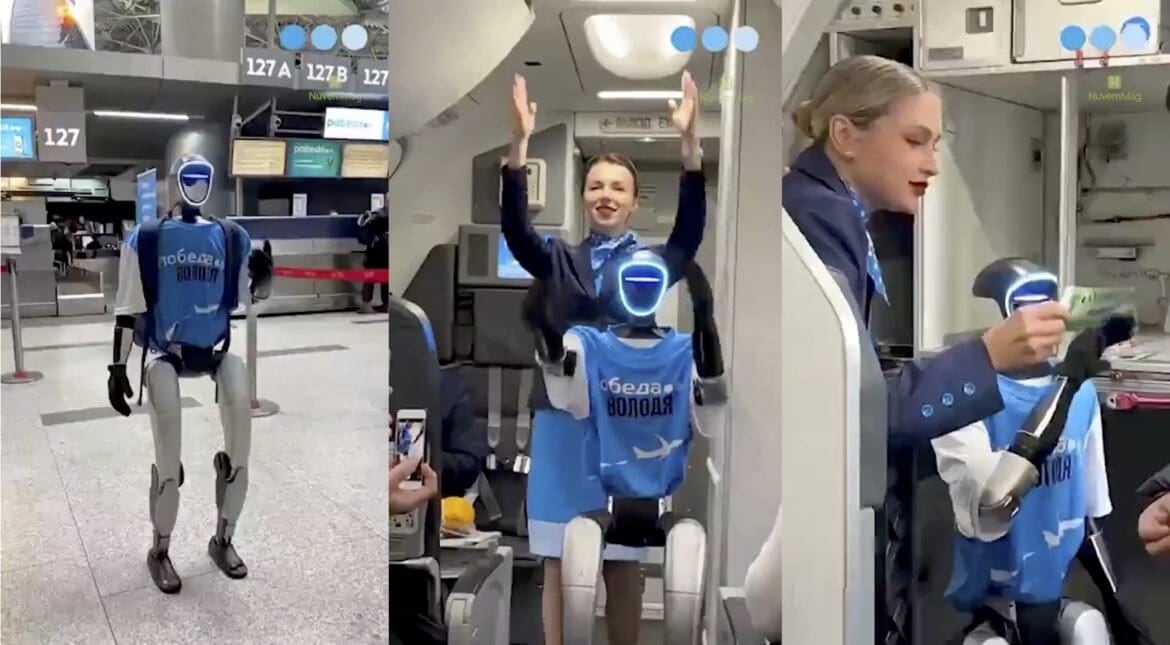Advertiser & Editorial Disclosure: The Bulkhead Seat earns an affiliate commission for anyone approved through the links below. This compensation may impact how and where links appear on this site. We work to provide the best publicly available offers to our readers. We frequently update them, but this site does not include all available offers. Opinions, reviews, analyses & recommendations are the author’s alone, and have not been reviewed, endorsed, or approved by any of these entities.
Pobeda Airlines, Russia’s largest low cost carrier and a subsidiary of Aeroflot, operated a flight that drew widespread attention across the aviation world. On November 12th, the airline introduced Volodya, a humanoid robot flight attendant helper during a domestic service from Moscow Vnukovo Airport (VKO) to Ulyanovsk Baratayevka Airport (ULV).
Volodya interacted with travelers throughout the flight, greeted passengers at the gate, welcomed them onboard, and assisted with a manual-style safety demonstration. The robot’s movements are driven by advanced reinforcement learning technology designed to mimic the actions of human flight attendants.
As seen in a video shared above, the robot’s presence appeared to be more theatrical than functional. Volodya is not capable of autonomously conducting safety demonstrations or performing essential inflight duties such as serving food and beverages. Observers noted that the robot strongly resembles the G1 model produced by Unitree Robotics in China.
The robot’s debut raised questions about the future of automation in the cabin. Some see it as a precursor to potential workforce changes, even though the current model cannot meaningfully replace human flight attendants. Others noted that tasks like safety briefings could easily be handled by onboard screens. For many passengers, being greeted by a robot may represent a decline in human interaction during travel.
This seems to have been a one-off publicity stunt rather than a substantive operational change. Passengers and aviation enthusiasts naturally find the concept intriguing and the airline likely anticipated the viral reaction.
While AI and robotics continue advancing at a rapid pace, the practical application of humanoid robots in commercial aviation remains limited. Whether such technology becomes a genuine part of the passenger experience or remains an occasional novelty will depend on future developments and the pace at which robotics can meet the safety, service, and regulatory demands of commercial flight.

We recently had Boston Dynamics’ Spot® – The Agile Mobile Robot at one of our events and robotics are moving fast. I got to steer Spot® and its as terrifying as it is exciting. A video shown provided a glimpse of all of the tasks that other robots being designed will soon perform: driving, packing boxes, loading trucks, etc.
Anthony’s Take: Volodya’s debut offers a glimpse into what the future might hold, but we have quite a ways to go before flight attendants are replaced with robots.
(Featured Image Credit: @Nuvemmag via X.)
(H/T: One Mile at a Time.)
User Generated Content Disclosure: The Bulkhead Seat encourages constructive discussions, comments, and questions. Responses are not provided by or commissioned by any bank advertisers. These responses have not been reviewed, approved, or endorsed by the bank advertiser. It is not the responsibility of the bank advertiser to respond to comments.
Advertiser & Editorial Disclosure: The Bulkhead Seat earns an affiliate commission for anyone approved through the links above This compensation may impact how and where links appear on this site. We work to provide the best publicly available offers to our readers. We frequently update them, but this site does not include all available offers. Opinions, reviews, analyses & recommendations are the author’s alone, and have not been reviewed, endorsed, or approved by any of these entities.
